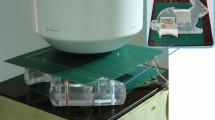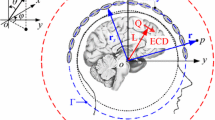Abstract
The problem of estimating magnetic nanoparticle distributions from magnetorelaxometric measurements is addressed here. The objective of this work was to identify source grid parameters that provide a good condition for the related linear inverse problem. The parameters investigated here were the number of sources, the extension of the source grid, and the source direction. A new measure of the condition, the ratio between the largest and mean singular value of the lead field matrix, is proposed. Our results indicated that the source grids should be larger than the sensor area. The sources and, consequently, the magnetic excitation field, should be directed toward the Z-direction. For underdetermined linear inverse problems, such as in our application, the number of sources affects the condition to a relatively small degree. Overdetermined magnetostatic linear inverse problems, however, benefit from a reduction in the number of sources, which considerably improves the condition. The adapted source grids proposed here were used to estimate the magnetostatic dipole from simulated data; the L2-norm, residual, and distances between the estimated and simulated sources were significantly reduced.





Similar content being viewed by others
References
Anderson E, Bai Z, Bischof C, Blackford S, Demmel J, Dongarra J, Du Croz J, Greenbaum A, Hammarling S, McKenney A, Sorensen D (1999) LAPACK users’ guide, 3rd edn. SIAM, Philadelphia, PA. http://www.netlib.org/lapack/lug/
Babinec P, Krafčík A, Babincová M, Rosenecker J (2010) Dynamics of magnetic particles in cylindrical halbach array: implications for magnetic cell separation and drug targeting. Med Biol Eng Comput 48(8):745–753. doi:10.1007/s11517-010-0636-8
Baumgarten D, Liehr M, Wiekhorst F, Steinhoff U, Münster P, Miethe P, Trahms L, Haueisen J (2008) Magnetic nanoparticle imaging by means of minimum norm estimates from remanence measurements. Med Biol Eng Comput 46(12):1177–1185. doi:10.1007/s11517-008-0404-1
Bharali DJ, Mousa SA (2010) Emerging nanomedicines for early cancer detection and improved treatment: current perspective and future promise. Pharmacol Ther 128(2):324–335. doi:10.1016/j.pharmthera.2010.07.007
Brauer H, Haueisen J, Ziolkowski M, Tenner U, Nowak H (2000) Reconstruction of extended current sources in a human body phantom applying biomagnetic measuring techniques. IEEE Trans Magn 36(4):1700–1705. doi:10.1109/20.877770
Cherukuri P, Glazer ES, Curleya SA (2009) Targeted hyperthermia using metal nanoparticles. Adv Drug Deliv Rev 62(3):339–345. doi:10.1016/j.addr.2009.11.006
Clark J, Braginski AI (eds) (2006) The SQUID handbook, vol 2: applications of SQUIDs and SQUID systems. Wiley-VCH, New York
Demmel JW (1987) On condition numbers and the distance to the nearest ill-posed problem. Numer Math 51(3):251–289. doi:10.1007/BF01400115
Demmel JW, Gu M, Eisenstat S, Slapnicar I, Veselic K, Drmac Z (1999) Computing the singular value decomposition with high relative accuracy. Linear Algebra Appl 299:21–80. doi:10.1016/S0024-3795(99)00134-2
Eichardt R, Baumgarten D, Di Rienzo L, Linzen S, Schultze V, Haueisen J (2009) Localisation of buried ferromagnetic objects based on minimum-norm-estimations—a simulation study. Int J Comput Math Electron Electron Eng 28(5):1327–1337. doi:10.1108/03321640910969566
Eichardt R, Haueisen J (2010) Influence of sensor variations on the condition of the magnetostatic linear inverse problem. IEEE Trans Magn 46(8):3449–3453. doi:10.1109/TMAG.2010.2046149
Gorodnitsky IF, George JS, Rao BD (1995) Neuromagnetic source imaging with FOCUSS: a recursive weighted minimum norm algorithm. Electroencephalogr Clin Neurophysiol 95(4):231–251. doi:10.1016/0013-4694(95)00107-A
Hansen PC, O’Leary DP (1993) The use of the L-curve in the regularization of discrete ill-posed problems. SIAM J Sci Comp 14(6):1487–1503. doi:10.1137/0914086
Hanson RJ (1971) A numerical method for solving fredholm integral equations of the first kind using singular values. SIAM J Numer Anal 8(3):616–622. doi:10.1137/0708058
Higham DJ (1995) Condition numbers and their condition numbers. Linear Algebra Appl 214:193–213. doi:10.1016/0024-3795(93)00066-9
Jain KK (2010) Advances in the field of nanooncology. BMC Med 8:83. doi:10.1186/1741-7015-8-83
Lim C, Han J, Guck J, Espinosa H (2010) Micro and nanotechnology for biological and biomedical applications. Med Biol Eng Comput 48(10):941–943. doi:10.1007/s11517-010-0677-z
Nalbach M, Dössel O (2002) Comparison of sensor arrangements of MCG and ECG with respect to information content. Phys C 372–376:254–258. doi:10.1016/S0921-4534(02)00683-4
Pankhurst QA, Thanh NKT, Jones SK, Dobson J (2009) Progress in applications of magnetic nanoparticles in biomedicine. J Phys D Appl Phys 42(22). doi:10.1088/0022-3727/42/22/224001
Pascual-Marqui RD (2002) Standardized low resolution brain electromagnetic tomography (sLORETA): technical details. Method Find Exp Clin Pharm 24(D):5–12
Rouve LL, Schmerber L, Chadebec O, Foggia A (2006) Optimal magnetic sensor location for spherical harmonic identification applied to radiated electrical devices. IEEE Trans Magn 42(4):1167–1170. doi:10.1109/TMAG.2006.872016
Schnabel A, Burghoff M, Hartwig S, Petsche F, Steinhoff U, Drung D, Koch H (2004) A sensor configuration for a 304 SQUID vector magnetometer. Neurol Clin Neurophysiol 70. http://www.neurojournal.com/article/view/284
Su D, Ma R, Salloum M, Zhu L (2010) Multi-scale study of nanoparticle transport and deposition in tissues during an injection process. Med Biol Eng Comput 48(9):853–863. doi:10.1007/s11517-010-0615-0
Su D, Ma R, Zhu L (2011) Numerical study of nanofluid infusion in deformable tissues for hyperthermia cancer treatments. Med Biol Eng Comput 49(11):1233–1240. doi:10.1007/s11517-011-0819-y
Wahba G (1977) Practical approximate solutions to linear operator equations when the data are noisy. SIAM J Numer Anal 14(4):651–667. doi:10.1137/0714044
Weichert F, Schröder A, Landes C, Shamaa A, Awad S, Walczak L, Müller H, Wagner M (2010) Computation of a finite element-conformal tetrahedral mesh approximation for simulated soft tissue deformation using a deformable surface model. Med Biol Eng Comput 48(6):597–610. doi:10.1007/s11517-010-0607-0
Acknowledgments
We thank Uwe Graichen for his comments to the Appendix. This study was supported in part by the German Federal Ministry of Economics and Technology (KF2250108WD1) and by the German Research Foundation (GK 1567 and clinical research group KFO 213).
Author information
Authors and Affiliations
Corresponding author
Appendix
Appendix
1.1 Accuracy of the condition number κ
The singular value decomposition of the lead field matrices in this application was accomplished using the LAPACK’s DGESVD routine. Anderson et al. (section 4.9.1 of [1]) show that the DGESVD produces deviations in the computed SVs of \(\hat{\sigma}_i\) relative to the true values \(\sigma_i, \) bounded by
The floating-point relative accuracy \(\epsilon\) was 2.2e−16 on the 64-bit systems used for our computations. Therefore, high relative accuracies of \(\hat{\sigma}_i\) are only obtained for SVs close to \(\sigma_1. \) Because the smallest SV \(\sigma_n\) is very small in relation to \(\sigma_1\) in this and many other applications, even low absolute errors in \(\sigma_n\) indicate high relative errors and lead to high absolute errors in \(\sigma_n^{-1}\) and \(\kappa. \)
Considering the definition (2), the accuracy of \(\kappa\) crucially depends on \(\sigma_n. \) Using the inequality (8), we obtain, for the relative error of \(\sigma_n\)
Consequently, the values of \(\kappa\) may be inaccurate, even in the order of magnitude, for \(\kappa \geq \epsilon^{-1}. \) Demmel [8] and Higham [15] stated that the condition number for computing the condition number is the condition number.
For special classes of matrices, it is feasible to compute all SVs, including the tiny SVs, with a high relative accuracy. An overview of this topic is provided by Demmel et al. [9]. This is not possible for general dense matrices, such as the lead field operators employed in our application.
1.2 Condition of the TSVD-regularized linear inverse problem
To facilitate stable linear inverse solutions, regularization methods are applied to improve the condition. For example, when computing a linear inverse solution using the TSVD approach (7) and a regularization parameter r, with \(1\leq r \leq n, \) all singular components with SVs smaller than \(\sigma_r\) are omitted. Depending on the parameter r, the TSVD regularization changes the linear IP and causes a regularization error, which should be smaller than the error that results from an inferior condition.
To measure the condition of the TSVD-regularized linear inverse problem for a lead field matrix L, the definitions of \(\kappa\) and ρ, (2) and (3), are modified to consider the largest r SVs only:
From (2) and (10), we obtain for any r between 1 and n
The property (12) follows because \(\sigma_1\geq\sigma_r\geq\sigma_n. \) A proof for (13) is shown in Sect. “Proof of \(1\leq \rho_{\rm tsvd} \leq \rho\)” of the Appendix. According to (12) and (13), \(\kappa\) and ρ are the least upper bounds for \(\kappa_{\rm tsvd}\) and \(\rho_{\rm tsvd}. \) In practice, the optimal choice of r for a matrix L and the resulting values of \(\kappa_{\rm tsvd}({\mathbf{{L}}},r)\) and \(\rho_{\rm tsvd}({\mathbf{{L}}},r)\) can vary widely.
1.3 Proof of \(1\leq \rho_{\rm tsvd} \leq \rho\)
To prove \(1 \leq \rho_{\rm tsvd}({\mathbf {L}},r) \leq \rho({\mathbf {L}}), \) we first show that \(\rho_{\rm tsvd}({\mathbf {L}},r)\) is smaller or equal \(\rho({\mathbf {L}})\) for all regularization parameters r between 1 and n:
which is provided by the singular value decomposition of L. Second, from \( \sigma_{1}({\mathbf {L}})\geq\sigma_{i}({\mathbf {L}}) \) follows \( r \times \sigma_1({\mathbf {L}}) \geq \sum_{i=1}^r \sigma_i({\mathbf {L}}) \) and \( 1 \leq \rho_{\rm tsvd}({\mathbf {L}},r). \) \( \square\)
Rights and permissions
About this article
Cite this article
Eichardt, R., Baumgarten, D., Petković, B. et al. Adapting source grid parameters to improve the condition of the magnetostatic linear inverse problem of estimating nanoparticle distributions. Med Biol Eng Comput 50, 1081–1089 (2012). https://doi.org/10.1007/s11517-012-0950-4
Received:
Accepted:
Published:
Issue Date:
DOI: https://doi.org/10.1007/s11517-012-0950-4




